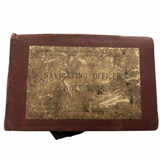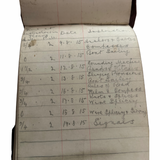1914 ORIGINAL WORLD WAR I MANUSCRIPT NOTEBOOK HANDWRITTEN BY A BRITISH NAVIGATION OFFICER SOON TO BE IN THE MOST NOTED NAVAL BATTLE OF THE WAR
8227On offer is a fascinating literary relic from a ship that was involved in one of the great Naval battles of World War One, kept by a lieutenant who would fight on this very ship in the significant Battle of Jutland..
The journal is entitled Navigating Officer's Note Book. The owners name is not on the book, just his ship. Research suggests that it belonged to Lieutenant Charles Hammill, RN (1891-1980). This is the normal rank for a Navigating Officer and there are several other journals kept by Hammill that are extant.
The notebook contains a number of sections showing Hammill’s trajectory as he trained for his role on the HMS Colossus. First is several pages of notes from Seamanship classes spanning February, 1914 to August, 1915. It opens with a list of names – likely class members. That is followed with a listing of topics studied and the hours spent on each: Splicing wire, knots and splices, lead line, rules of the road, anchors, etc. Over the time period of February 16 through Oct 26, 1914, he lists the various topics he has to study.
The next section of the notebook contains handwritten details of the HMS Colossus:
“Colossus – Particulars of Ship…Length between perpendiculars – 510 ft…Length Exterior – 546 ft...Breadth – 55 ft…Displacement 27 ft draught – 20,000 tons…Fully loaded – 30 ft 6 in – 20,300 tons…Horse Power – 25,000 hp…” [and the list continues for 10 pages].
He makes six pages of notes about the various lines on board (there are no ropes on a ship). He also discusses and provides definitions related to one of the most important books on board – the deck log:
“The Deck Log Supplied for registering everything that happens on ship. Kept up-to-date by Officer Of Watch under Navigating Officer. Two logs in use. Fair and Rough. Fair kept by Navigating Officer. Rough kept in gangway by Quartermaster. In front pages you will find the following tables for registering the state of weather, state of sea and force of wind….”
What follows is a list of abbreviations that the Royal Navy used to record that information. He also notes the rules for operating various things on the ship, with headings such as “Rules of the Road”, “Fog Signals”, “Fog Horn”, “Collision Mat(?)”, and a section describing all the rooms on the ship.
This is a fine piece of naval history. A naval historian would find its description of training a useful piece of corroboration. A collector of militaria would appreciate that this notebook was most likely carried into one of the great naval battles of WWI.
BIO NOTES AND HISTORY:
In the run-up to WWI, the Royal Navy constructed a number of new, massive battleships. Named after the first such ships, these 'dreadnoughts' revolutionized big-ship construction with their emphasis on size, massive armament and steam propulsion. HMS Colossus was the lead ship of her class of two dreadnought battleships built for the Royal Navy 575 feet long, she displaced nearly 24, 000 tonnes. Her main armament consisted of 10 12-inch guns plus many more secondary and specialized weapons.
Charles Ford Hammill was attached to Colossus as a Lieutenant. He came from a naval family where both his father and his brother served as Royal Navy officers, both in time being promoted to Captain. Born in 1891, he joined the Royal Navy in 1905 as a midshipman. As a midshipman, he kept a journal that was full of notes and drawings. After being commissioned he was at some point transferred to HMS Colossus.
One of the great naval battles of WWI was the Battle of Jutland. In an attempt to lure out and destroy a portion of the British Grand Fleet, the German High Seas Fleet, composed of sixteen dreadnoughts, six pre-dreadnoughts and supporting ships, sortied early on the morning of May 31st, 1916. The two fleets numbered 250 ships between them. In the ensuing battle, Colossus engaged several German warships, receiving very light damage. Fourteen British and eleven German ships sank, with great loss of life. Although both sides claimed victory, Britain's long-term goal of bottling up the German fleet was successful as they never sortied again.
This book measures 6.25 inches by 4 inches and contains 164 pages. It is about 50% complete. The Journal was issued for the use of Junior Officers by the Royal Navy. The covers are a brown/maroon cloth over marbled boards. The pages are faintly lined. The style is flip-top. Both the covers and the pages are in good condition.
Please don't hesitate to contact us for more information or to request photos. (Kindly include the SKU, listed on this page above the price, in your e-mail so we can more easily answer your questions.)









